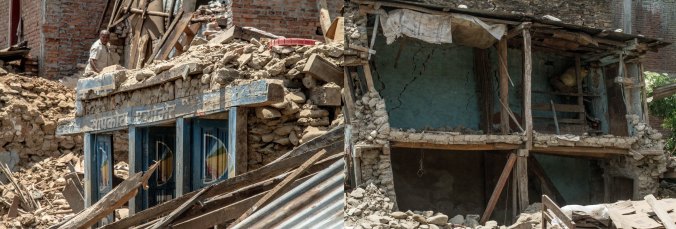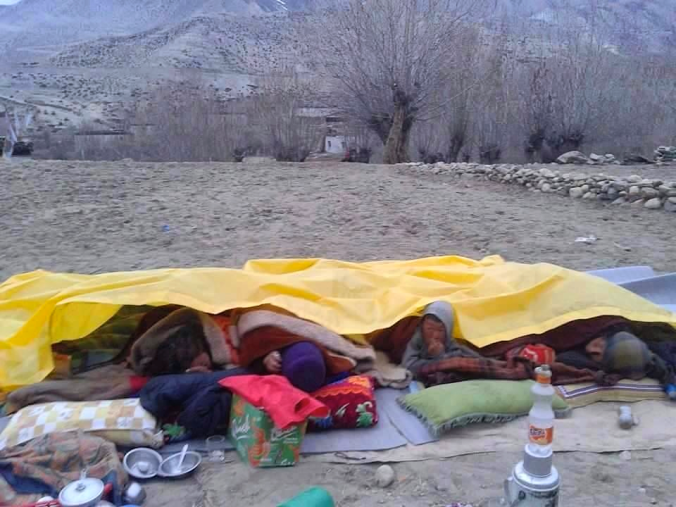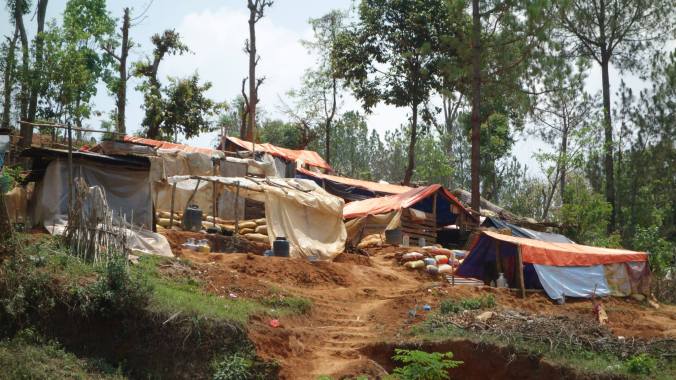It was less than a week after the April 25th, 2015 magnitude 7.8 earthquake hit Nepal that we came to realize little-to-no relief had reached villages beyond Kathmandu. Roads were dangerous; But even worse, as time progressed, supplies for temporary shelter for the over 2 million now homeless had dried up. Tents and tarps were sold out in Kathmandu. Foreign governments and aid organizations were being shut down at the airport, their incoming supplies requisitioned by Nepal customs, and much-needed food, tents, tarps, blankets, and medical supplies were sitting on the runway, tied up in a confounding wad of red tape.

© Anup Gurung
Our friends in Nepal were frantic, texting us asking for any means to get materials over to the remote villages. Aid organizations trucking supplies to villages were stopped along the roads by desperate, angry, and hungry people who lived right along the road who also had seen no relief. Supplies were ripped from trucks and middlemen sold them at high prices to anyone who would pay. These were the stories coming out of Nepal.

Our friends in the Mustang village of Ghiling had no housing. They were surviving below-freezing temperatures living under a tarp as their homes were destroyed.
My mountaineering/photographer friend, Jake Norton, and I immediately set up a Facebook group with a few more friends who could brainstorm together to come up with a solution. We all had experience in Nepal or with disaster relief and we had a unique idea we wanted to test: Could we start a person-to-person underground railroad to bring relief to the blank spots on the media map, the forgotten corners of Nepal where people were in trouble, circumventing customs altogether? Through each of our own personal friendships and connections, we created a network of travelers to Nepal who could carry duffels as excess baggage with them on airlines. As tourists entering the country, they whisked right through customs and our friends, Nepali mountaineers, kayakers, and guides, could then get the supplies and health care up to far flung villages. They were local, knew the terrain well, and could take on any conditions or logistics thrown their way. The idea was bold, would involve a worldwide network, the complicity of some airlines, and some social media hacks to pull it off.

Jonathan Marrs’ luggage, filled with tents, tarps, and medical supplies for Nepal.
Through the help of The Buy Nothing Project, we immediately set to work in the major cities where we have thriving local gift economies. Seattle was our first test: Shelley Schwinn, the project’s coordinating admin, posted to some 500 groups in greater Seattle and through friends who own the Nepali clothing company, Sherpa Adventure Gear, we sent off 22 duffels in a private shipping container they were able to put on Northwest Airlines just as they would a regular clothing shipment to Nepal.

One tarp per family in Listi, VDC, to keep them dry from monsoonal rains, thanks to Ang Tshering Lama. © Ang Tshering Lama
We then got word out through The Buy Nothing Project and our own social networks in all major cities that we were looking for anyone headed to Nepal, to add a few additional pieces to their luggage. We would take care of the airlines side of the equation, petitioning excess baggage departments and receiving waivers from them for humanitarian relief. United Airlines and Etihad were our most supportive airlines, waiving hundreds of bags through their systems as accompanied excess loads headed to the Himalaya with doctors, climbers, scientists, filmmakers, and relief volunteers. Our requests for donations through social media came with this preamble:
We’re a person-to-person gifting network working to provide temporary shelter for the marginalized people left homeless by the April 25 earthquake in Nepal. We’re a worldwide network of mountaineers, filmmakers, doctors, scientists, and Nepalis creating an underground railroad to the most affected villages, delivering pre-packed duffel bags filled with family-size tents and tarps into the hands of anyone willing to ship them or courier them into Nepal.
Friends in Boulder, Colorado networked in their climbing community for duffels, tents, tarps and medicines needed, while the Buy Nothing groups in San Francisco, Indiana, Ohio, Washington DC, Massachusetts, and New Hampshire rallied to find the same. It was a race against time, matching travelers with fully-packed duffels and a welcoming committee on the Nepal side who would pick them up at the airport, gather the duffels from them, and take them to their destination in Kathmandu.

Two bags at a time, thanks to Krissy Moses, Lindsey MacMillan, and Sapan Ghimire
Our Facebook group was mission control, the inner workings of our hacker culture we’d set up to circumvent all roadblocks. But new ones came at us every day, and we’d then have to come up with a counter-move, much like Minecraft. We built secret tunnels to get duffels into Nepal in broad daylight.
In the end, in 2 months’ time, our Person 2 Person 4 Nepal network, was able to collect, ship, and deliver 240 duffels, filled with over 700 family-size tents & tarps, 100 solar chargers, blankets, medical supplies, and hundreds of solar lights at little to no cost to us, all before the monsoon arrived. These supplies are valued at over $67,000.

We believe this kind of person-to-person worldwide network can make a difference in any disaster and is a viable alternative model to work in parallel with the larger aid agencies on the ground. When a landslide struck Oso, WA The Buy Nothing Project was able to get over 4 tons of food and supplies to the people of Oso, well before the Red Cross arrived. People naturally want to help. Harnessing that rush-to-help through local gift economies and social networks can have a huge impact when organized directly with those affected. Aid organizations always say, “Don’t give things, give money. And, don’t go there yourself.” In our experience, this advice is ill-given, as supplies and food in Nepal were scarce. Bringing the supplies there, in person, was necessary.

© Anup Gurung
The individual stories of our Nepal efforts are quite wonderful: United Airlines pilot, Matt Murray for example, volunteered to fly for free as a passenger on his days off to singlehandedly jet 100 duffels of tents and tarps to Nepal.

United Airlines Pilot, Matt Murray, with his relief duffels
An Everest climber, David Carter, took time off from work in Indiana to fly to Nepal with 2 of his friends, just to courier 100 solar chargers for us. These chargers have been instrumental in helping the people of Rasuwa and the Langtang village survivors in particular. It’s the individual stories that tell a broader narrative of how community-based sharing and gift economy networks can mobilize to make a difference in times of need. We’re using the connectedness we experience through social media to transform our professional and social networks of trust into action on the ground.

Our mountaineer/kayaker friends brought thousands of pounds of rice and supplies up to forgotten villages. ©Anup Gurung
The blue stars on this map below highlight our distribution areas for temporary shelter and life-saving supplies compared to the people most in need, post-earthquake, in Nepal.

You’ll see the results of this effort in the NOVA documentary airing tomorrow night (Wednesday, January 27th, 2016) at 9pm. You’ll see the local hands-on rescue team of Nepali Nurses and outdoor athletes who took matters into their own hands to bring relief to people in the hinterland. You’ll see volunteer American doctor, Bruce Gardner, bringing simple medical care to those who might need it — wellness checks, follow-through care for those more deeply affected by the earthquake. And you’ll see the utter devastation wrought by a 7.8 earthquake that could have been much worse.

Dr. Bruce with Seema Tamang, who was buried for 24 hours under the rubble of her home. ©Liesl Clark
We have so many of you to thank. Please watch the film and share this graphic with friends and family as an example of what’s possible, to let them know that people can connect-the-dots to create an international gift economy, a social movement jetting, trucking, and hand-carrying supplies to people in need on the other side of the globe. If we had to do it again, we would, and we’ll keep working to bring what’s needed to our friends, old and new, in Nepal.

My dear friend Karsang finally had a roof over her head, thanks to a caring network of friends in Nepal.
So inspiring! Very well written piece too
LikeLike
Aw, thanks Libbyvine! Group effort all around.
LikeLiked by 1 person
A wonderful humanitarian effort from a grassroots level. I wish the article was more detailed with time frames of the response. The disaster was April 2015, and there is much said about the effectiveness of this effort, but there are few details as to how long it took for the actual aid response. Since it is nine months post event, I am wondering if this is just a social media advert for the Nova documentary. I certainly hope not.
LikeLike
Hi Len: All of the efforts, written about here in this article, happened within the first 2 months after the earthquake. You can see the timing of it in our real-time facebook group, where the dates of the posts speak for themselves: https://www.facebook.com/Person2Person4Nepal/?fref=ts
I do appreciate your concerns, but the fact is that it had taken me this long to write this article because we were racing to make the film for NOVA and deliver it to PBS in time. Now that it’s airing tonight, it was time to get this story written, to start the dialogue about how locally-driven efforts in Nepal were extremely effective in the early days right after the quake. We tried to get the word out to media about this kind of effort, but the media was more interested in stories about what didn’t work in Nepal. With this worldwide network of real people leading the charge and finding dirt-bag-style solutions to getting goods into the country, we’ve learned that this can actually work. I apologize for not having the time to get this story out earlier to give credit to those, both in country and worldwide, who did the lion’s share of carrying the load and troubleshooting for Nepal.
LikeLiked by 1 person
Pingback: How Underground Networks Can Outperform Aid Orgs – konviktion
Resourceful brave and organised love you all for such caring actions that are so essential chhers Janey
LikeLike
Thank you so much, Janey. Our efforts were just one small part of what so many other locally-lead teams were able to accomplish. Thank you for taking the time to read this story.
LikeLike
This story deserves a wider audience and well done on all your efforts to provide one. We all sit at home watching or reading the news about such disasters and other than donating money to relief organisations, we think there’s nothing else to be done and move on to the next news item. Congratulations to you and everyone involved in this scheme for looking at the bigger picture and really making a difference. With so many disasters of one kind or another in the world, it can often be overwhelming if not paralysing. Thank you on behalf of the rest of us for all the work you have done to support so many who might otherwise have perished. 👏🏻
LikeLiked by 2 people
Many many thanks for your kind words. This was definitely a group effort, so I’ll thank you on behalf of this incredible group of people who dropped everything for several weeks to devote their lives toward doing all they could to simply troubleshoot a frustrating political situation and get out there and apply their talents wherever they could.
LikeLiked by 1 person
Reblogged this on pearsnotparsnipsdotcom and commented:
We all sit at home watching or reading the news about disasters such as last year’s earthquake in Nepal and, other than donating money to relief organisations, we think there’s nothing else to be done and move on to the next news item. With supplies being tied up in red tape, stolen or resold at exorbitant prices and eventually running out, these individuals looked at the bigger picture and via social media organised an underground relief network that really did make a difference to many villagers who might otherwise have perished. With so many disasters of one kind or another in the world, it can often be overwhelming if not paralysing. This article shows how it can be done and will hopefully stir others into action. Please read and repost.
LikeLiked by 1 person
Thank you so much for sharing, and helping to get the word out!
— Liesl at Pioneering The Simple Life
LikeLiked by 1 person
No probs, already had a few views. 👍🏻
LikeLiked by 1 person
Pingback: The Many Crises of Nepal | Center for Disaster Philanthropy
Hi Liesl, The Guardian newspaper has an article about local people helping each other before aid arrived after the earthquake. Christian Aid are eager to learn from experience and thought you might be interested. I sent your link to The Guardian on Twitter.
LikeLiked by 1 person
Thanks, Chris. Let’s see if we can get this story under their noses. I appreciate your help.
LikeLiked by 1 person